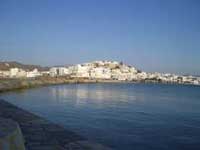Naxos is the largest island (428 km² ) in the Cyclades island group in the Aegean Sea, which separates Greece and Turkey. The island was the centre of archaic Cycladic culture, then part of classical Greek culture, and is part of modern Greece. It is a popular tourist destination, with easily accessible ruins. One set of ruins is what is left of a temple built on a rocky beach. Long ago there was an earthquake sending most of the temple into the sea. Still standing, however, are two columns with a single lintel across them. The remains of the structure resting in the sea can be seen from the shore and explored by swimmers. Naxos has many very beautiful beaches, such as those at Agia Anna, Agios Prokopios, Alikos, Kastraki, Mikri Vigla, Plaka, and Agios Georgios at Hora, the capital of the island, which has 6533 inhabitants (2001 census). Naxos is famous as the most fertile island of the Cyclades. It has a good supply of water in a region where water is usually inadequate. Mount Zas ( 1,004 metres) is the highest peak in the Aegean Sea, and tends to trap the clouds, permitting greater rainfall. Mythic Naxos Homer mentions “Dia” literally the sacred island "of the Goddess". Karl Kerenyi, speaking for the ancient Greeks explains ""This name, Dia, which means 'heavenly' or 'divine', was applied to several small craggy islands in our sea, all of them lying close to larger islands, such as Crete or Naxos. The name "Dia" was even transferred to the island of Naxos itself, since it was more widely supposed than any other to have been the nuptial isle of Dionysus". (Kerenyi 1951 pp271-2) According to mythology, in the Heroic Age before the Trojan War, on this island Theseus abandoned Ariadne, daughter of Minos, King of Crete, after she had helped him kill the Minotaur and to escape from the Labyrinth. Dionysus, god of the island and protector of wine, festivities, and the primal energy of life, met her and fell in love with her. But Ariadne, unable to bear her separation from Theseus, killed herself, according to the Athenians, or ascended to heaven, as the older versions had it. According to another story in the Greek mythology, the Aloadae had piled Mt. Ossa and Mt. Pelion on top of each other in front of Mt. Olympus, and were seen as a threat to the gods. To solve this problem, Artemis told Otus, one of the two brothers, that if he shall stop the siege of the Olympus she would come and be his lover at Naxos. Another story says that the Aloadae had actually settled Naxos. Reference History Revolt of Naxos In 502 BC the inhabitants of Naxos rebelled against their masters in the Persian Empire; this revolt led to the larger Ionian Revolt, and then to the Persian War between Greece and Persia. Greek and Byzantine Naxos During the 8th and 7th centuries BC , Naxos dominated commerce in the Cyclades. The Dukes of Naxos
Venetian Tower [Source] In the aftermath of the Fourth Crusade, with a Latin Emperor under the influence of the Venetians established at Constantinople, the Venetian Marco Sanudo conquered the island and soon captured the rest of the islands of the Cyclades, establishing himself as Duke of Naxia, or Duke of the Archipelago. Twenty-one dukes in two dynasties ruled the Archipelago, until 1566; Venetian rule continued in scattered islands of the Aegean until 1714. Ottoman Naxos, 1564-–1821 The Ottoman administration remained essentially in the hands of the Venetians; the Porte's concern was satisfied by the returns of taxes. Very few Turks ever settled on Naxos, and Turkish influence on the island is slight. Turkish sovereignty lasted until 1821, when the islands revolted; Naxos finally became a member of the Greek state in 1832. Persons
Manolis Glezos from Naxos Apeirantho, a stamp from the Soviet Union
Division of the municipality of Naxos, population 12089 (2001)
GE: Google Earth
Archaeological Sites Tsikalario
 |
|
|||||||||||||||||||||||||
|
|

























